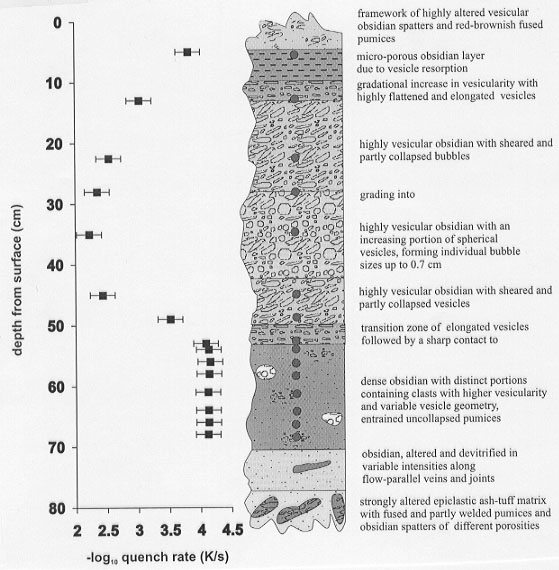

The ˜2ka sub-plinian eruption of Montaña Blanca was the last explosive phonolitic eruption within the Las Cañadas edifice on Tenerife, Canary Islands. Towards the end of the fissure eruption, two discrete horizons of welded fall out were generated by intense fire-fountaining. Welding occurred in proximal to ultraproximal localities overlying unwelded fallout pumices. The welded layers have undergone rheomorphism that produced lava-like, decimeter-thick deposits with variable porosity. Individual flattened and fiammé-like clasts indicate the clastogenic origin of the obsidian deposit that changes further downslope into a clastogenic lava flow.
The rheology of such rheomorphic deposits is strongly dependent on their thermal evolution with time. To assess the thermal history of these peralkaline obsidian flows (agpaitic index = 1.20), enthalpy relaxation geospeedometry (Fig. 3.6-9) has been performed using data from differential scanning calorimetry (DSC) and applying the Narayanaswamy approach (see Annual Report 1994). To quantify the thermal history of the deposit, an 80 cm vertical profile within one welded layer was sampled in detail. The modelled cooling pattern within the sequence is related to the degassing history of the clasts and the entire deposit. From a thin compacted and dense near-surface horizon, porosities steadily increase towards the interior of the flow. The central part of the sequence exhibits a transition from a highly vesicular to dense obsidian that overlies a non-welded pumice deposit. Within the entire sequence, modeled cooling rates differ by more than two orders of magnitude (Fig. 3.6-10). Cooling rates within the vesicular horizon differ between 0.006 and 0.0003 K/s. An annealing process is reflected by the cooling rates of the dense parts where the cooling pattern shows little variation around 0.00007 K/s.
The cooling history of the sequence cannot be described by general concepts of heat loss, including surface radiation, conduction or (forced) convection. The very slow cooling represented in the dense parts of the sequence is due either to a primary cooling process or, more likely, to annealing within the glass transition interval. The primary vesicularity of the dense parts of the flow has been erased by bubble collapse upon annealing. In addition, conductive heat loss to the substrate was probably hampered by the underlying highly vesicular fall-out pumices that represent a good thermal insulator. The thermal consequences of degassing can be studied in the porous parts of the obsidian deposit, where higher cooling rates are linked to a quench process due to the vesiculation. The exsolution of volatiles might lead to significant undercooling of a melt, due to increasing liquidus temperatures of tens or even hundreds of Kelvin. The endothermal nature of bubble growth and the enthalpy of exsolution may be the cause of extensive undercooling of a vesiculating melt. These processes may cause the significantly higher cooling rates modeled for the vesicular parts compared to the dense parts of the sequence.
From field and microscopic analysis the vesiculation process appear to be primarily post-depositional. However, primary clast porosities, though hard to quantify, have to be taken into account.
 |
Fig. 3.6-9: The normalized heat capacity traces of both measured (solid line) and modeled (dotted line) Cp-values of two samples with more than one order of magnitude difference in cooling rates within the glass transition. The measured traces are derived upon first heating of the extracted samples at 5 K/min approximately 50 K into the supercooled liquid field. The hysteresis in heat capacity displays the enthalpic relaxation of the sample within the glass transition. Quantifying this process allows the previous, in our case the natural, cooling rate to be modelled. The cooling rate of sample MB5-3.66 is 6 K/day using parameters log10A = -21.72 s;  H* = 404 kJ/mol; H* = 404 kJ/mol;  = 0.90; = 0.90;  = 0.60 and = 0.60 and  2 = 0.04. Cooling of sample MB5-4.45 was modeled at 320 K/day using log10A = -24.27 s; 2 = 0.04. Cooling of sample MB5-4.45 was modeled at 320 K/day using log10A = -24.27 s;  H* = 457 kJ/mol; H* = 457 kJ/mol;  = 0.90; = 0.90;  = 0.55 and = 0.55 and  2 =0.05. The correlation of increasing peak height due to previous slower cooling is clearly visible upon reheating through the glass transition. 2 =0.05. The correlation of increasing peak height due to previous slower cooling is clearly visible upon reheating through the glass transition. |
 |
Fig. 3.6-10: The thermal history of the vertical sequence MB5 within the glass transition. The modeled quench rates (log10 0.2 K/s uncertainty) are displayed as a function of depth from the surface of the deposit. The gray circles indicate the location of the samples within the sequence. The correlation between the degassing history and the cooling of the obsidian is clearly visible. The vesicular parts of the rheomorphic deposit show cooling rates up to two orders of magnitude faster than the dense horizon in the lower third. Cooling rates of 6 K/day modeled within the dense obsidians and the micro-porous transition zone towards the overlying vesicular vitrophyre suggest an annealing process enhancing structural relaxation resulting in further viscous deformation and collapse of existing vesicles. A similar process can be envisioned for the upper micro-porous obsidian (5 cm depth). The vesiculation of the central part of the deposit led to a significant adiabatic undercooling of the melt resulting in the preservation of up to 70 vol% void space. The cooling history of the entire deposit within the glass transition follows a complex thermal path. |
The slow cooling of the welded fall-out favors rheomorphism of the entire deposit, which lead to the formation of a > 100 m long clastogenic flow. Considering the extremely low cooling rates of the basal parts of the deposit within an annealing regime, viscous flow of the lava-like deposit may have been sustained for weeks or even months.

Tel: +49-(0) 921 55 3700 / 3766, Fax: +49-(0) 921 55 3769, E-mail: bayerisches.geoinstitut(at)uni-bayreuth.de
 Previous page
Previous page